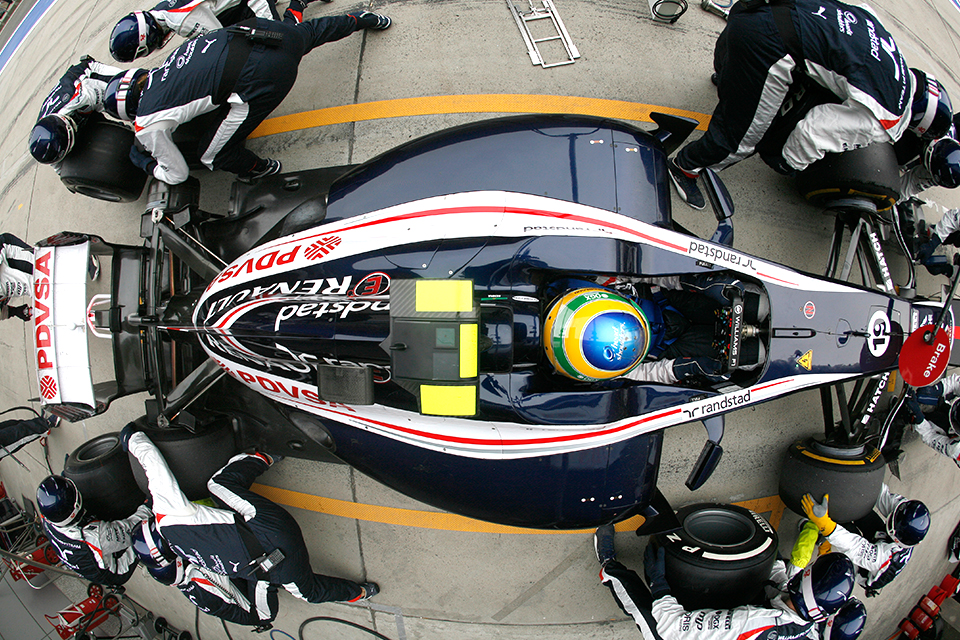Inside the Pit

An F1 pit stop is a very controlled atmosphere, though the slightest misstep can turn it into chaos. There are two ways to measure a pit stop: wheel-stop time (time to change all four wheels when the car is at a standstill) and total pit-lane time (time between the car’s entering and leaving the speed limited section in the pit lane).
The team manager has a loose plan for the race, which is roughly 200 miles in length. He confers with the race engineer and chief mechanic, which are specific to the team’s various drivers and the cars. The team manager calls the driver in (the Williams F1 drivers are Pastor Maldonado and Bruno Senna, nephew to former Williams driver Aryton Senna). During practice, cars enter the pit lanes at 60 kph (around 37 mph), though in qualifying rounds and races the maximum speed is raised to 80 kph (almost 50 mph).
There are two areas, called pit lanes. The closest to the pit is called the “fast lane” and the one closest to the garage is called the “inner lane.” The crew works in the garage and the inner lane during the race. The pit box is located within the inner lane, and this is the only area where pit stops occur. Crews are assigned to these areas at the various racing venues and, outside of sweeping and drying the pit box, no improvements can be made.
Personnel are only allowed in the pit box immediately before a stop; they may appear in position merely 20 seconds before the car enters. The lollypop man, called so because he holds a sign on a long pole (one side reads “brake” and the other “gear”) acts first. As the car comes in, the sign comes down, telling the driver to brake and put the car in neutral as well as acting as a visual cue to stop, positioned right before the driver’s cockpit. The front wheelmen crouch, holding their gloved hands out at wheel height, acting as another positional cue for the driver.
Before the car comes completely to rest, the four gunmen move in, removing each of the single wheel nuts and disengaging the locking device that holds the wheels. The rear and front jack men move in simultaneously and lift the car up; as the wheels are removed, the gunmen move back. The new wheels are put on and moved to make sure they are fully engaged, and the gunmen step back in to replace the wheel nuts, holding their hands above the wheels to show when they are in place and locked. The front and rear jack men drop the car. The lollypop man visually scans to see that all four gunmen have hands above the wheels and that any additional work, such as clearing debris from the car’s intake or making minor body repairs, has been completed. He checks the pit lane to see that no cars block the driver’s exit and flips the sign to “gear,” signaling to rev the engine to 12,000 rpm and engage first gear. When all conditions are right, the sign is lifted and the car speeds down the lane. The pit crew must immediately return to the garage area as soon as their work is complete.
Since 2010, there is no refueling during an F1 race. This change came about after several horrific accidents. The new ruling has resulted in changes in the number of crew (Williams’ crew numbered 23 while refueling was allowed), uniforms (pit crews now wear workpants and uniform shirts as opposed to four-layer, fire-retardant suits and helmets), and to the car. To allow for larger fuel tanks, cars are approximately a foot longer, which also affected crew positioning within the pit box. Perfect pit stop time went from ten seconds to three seconds.
Accidents happen in the pit box, such as Williams F1 Team’s lollypop man Carl Gaden’s mental mistake in the 2002 Spanish Grand Prix. Gaden lifted the lollypop, releasing the car before the fuel hose had fully disengaged; realizing his mistake, he reacted without thinking, throwing his foot in front of the left wheel in an attempt to stop the driver from exiting and was caught under the wheel. Miraculously, he was not seriously injured. Recently, four mechanics suffered from smoke inhalation when a fuel fire broke out after the 2012 Barcelona Grand Prix, ironically occurring as Maldonado was giving his winning speech after his first driving victory (and the Williams team’s first race victory since 2004). Video of the incident shows all pit crews regardless of affiliation racing to the Williams garage, and that quick reaction and selfless aid limited the majority of damage to equipment.






